Best Indoor Plants for Beginners: 14 Easy Care Houseplants
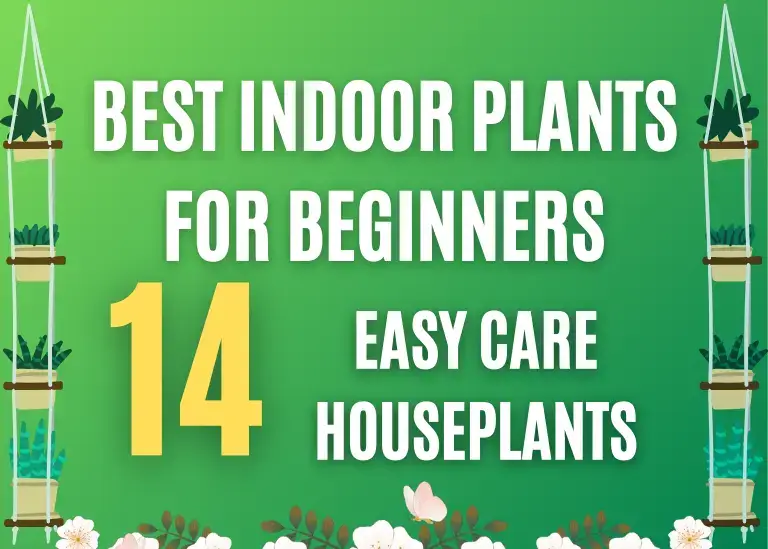
Does your green thumb seem to fade the moment you bring a plant indoors? You’re not alone. Many new plant parents struggle at first, but the secret isn’t magic — it’s choosing the best indoor plants for beginners.
These low-maintenance houseplants can handle a bit of neglect, adapt to different light levels, and bounce back even if you miss a watering or two. This guide will walk you through the easiest plants to grow at home.
To make it simple, I’ve grouped them by light needs — low light, medium/bright, and sunny windows — so you can match the right plant to your space and set yourself up for success.
The quickest way to set yourself up for plant success is to choose a plant whose light needs match the spot you’ll keep it in. A sun-lover will never be happy in a dark corner, no matter how much you water or fuss over it. Here are the best house plants for different microenvironments in your home and why are great for beginners.
- LOW LIGHT: Plants suitable for north-facing windows or interior rooms. They tolerate low light but may grow slower.
- MEDIUM/BRIGHT, INDIRECT LIGHT: Plants for east-facing windows or a spot a few feet back from a south/west window.
- BRIGHT LIGHT: Plants that need the direct sun of a south or southwest-facing window.
1. Snake Plant (Sansevieria trifasciata)
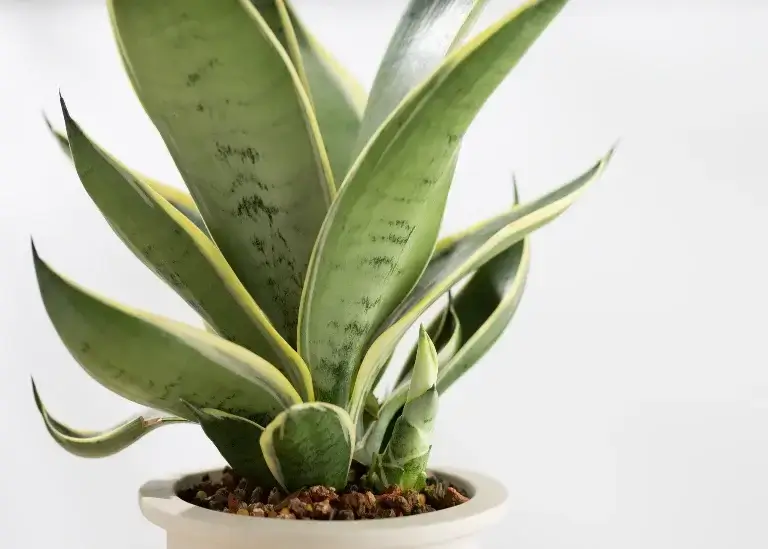
Low light tolerant | 60-85°F | Extremely low maintenance
The Snake Plant, with its striking upright, sword-like leaves featuring dark green coloration and yellow edges, stands as the most resilient houseplant for beginners. This architectural succulent thrives on neglect and forgives even the most forgetful plant parents.
Why it’s Perfect: This nearly indestructible plant survives in the darkest corners of your home and can go weeks without water. Its thick, fleshy leaves store water, making drought tolerance its superpower. Snake plants actually prefer being ignored – they’re more likely to suffer from too much attention than too little.
Essential Care Requirements:
- Light: Tolerates low to bright, indirect light; adaptable to almost any lighting condition
- Water: Let the soil dry all the way through before watering again—usually every 2 to 4 weeks depending on your home’s conditions
- Temperature: Comfortable in normal home temperatures (60-85°F)
- Humidity: Thrives in dry air; no humidity requirements
Growth and Maintenance: Snake Plants are slow growers, ranging from compact 6-inch varieties to impressive 4-foot specimens. Their vertical growth habit makes them perfect for corners and tight spaces where other plants won’t fit.
Care Schedule:
- Spring-Summer: Light feeding with half-strength balanced fertilizer once per season
- Fall-Winter: No fertilizing needed; reduce watering frequency
- Year-round: Dust leaves occasionally for optimal photosynthesis
Additional Benefits: NASA’s Clean Air Study ranks Snake Plants as top air purifiers, actively removing formaldehyde, benzene, and xylene while producing oxygen at night – making them ideal bedroom plants.
Success Tips:
- Use well-draining cactus soil to prevent root rot
- Choose terracotta pots for better moisture control
- If the leaves start turning yellow and feel soft or soggy, that’s a classic sign of too much water—the number one way these plants suffer.
- Propagate by division when repotting for free new plants
Learn more in my full Sansevieria trifasciataCare Guide
2. ZZ Plant (Zamioculcas zamiifolia)
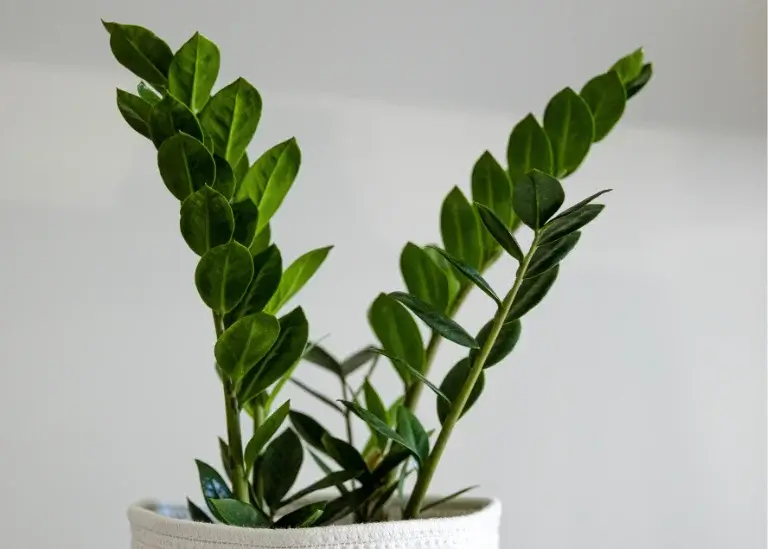
Low to bright indirect light | 65-85°F | Drought tolerant
The ZZ Plant combines stunning elegance with bulletproof durability. Its glossy, waxy pinnate leaves create a sophisticated appearance while its underground rhizomes store water for extended drought periods, making it virtually maintenance-free.
Why it’s Ideal: This architectural beauty looks expensive and high-maintenance but requires minimal care. Its water-storing rhizomes mean you can forget to water it for weeks without consequences. The glossy leaves naturally repel dust and maintain their shine with minimal effort.
Essential Care Requirements:
- Light: Adapts to low light but thrives in bright, indirect light
- Water: About every 2–3 weeks, making sure the soil has fully dried out before adding more
- Temperature: Prefers warm conditions (65-85°F)
- Humidity: Normal household humidity is perfect
Growth and Maintenance: ZZ Plants grow slowly but steadily, typically reaching 2-3 feet tall and wide. Their compact, upright growth makes them perfect for desks, shelves, or floor displays without taking up much space.
Care Schedule:
- Spring-Summer: Diluted liquid fertilizer every 3-4 months
- Fall-Winter: No fertilizing; water less frequently
- Year-round: Wipe leaves monthly for maximum gloss
Additional Benefits: Beyond its low-maintenance nature, the ZZ Plant’s architectural form serves as living sculpture, adding modern elegance to any space while requiring virtually no care.
Beginner Success Tips:
- Overwatering is the only real threat – when in doubt, don’t water
- Yellow leaves typically indicate too much water
- Slow growth is normal – don’t expect rapid changes
- All parts are toxic to pets and children
Safety note: Keep away from children and pets as all parts are toxic if ingested.
3. Pothos (Epipremnum aureum)
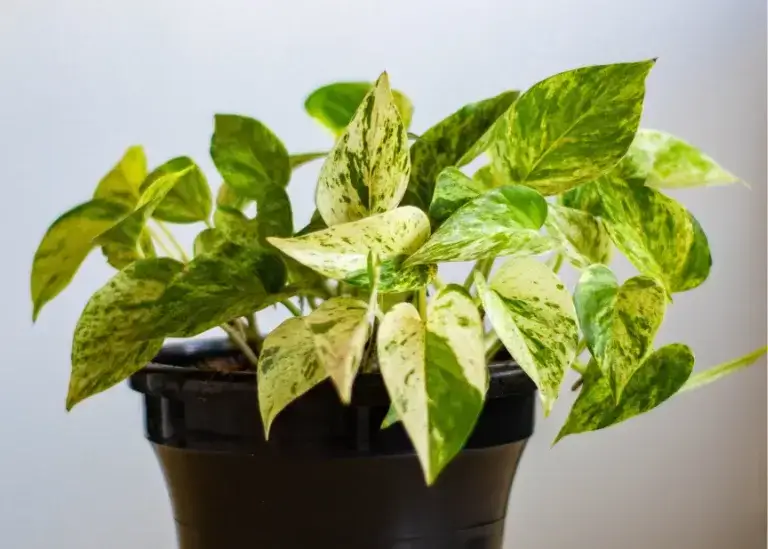
Low to bright indirect light | 65-85°F | Easy to care
Pothos stands out as the ultimate beginner-friendly houseplant, featuring distinctive heart-shaped leaves in green, golden, or cream variegations. This fast-growing trailing vine is virtually indestructible and adapts to almost any indoor environment, making it perfect for new plant parents.
Why it’s Ideal: This resilient plant forgives watering mistakes, tolerates low light conditions, and grows rapidly to provide quick satisfaction. Pothos actually signals when it needs water – leaves become slightly less firm – then perks up within hours of watering. Many growers successfully propagate cuttings in just water, making it an excellent plant for learning propagation techniques.
Essential Care Requirements:
- Light: Loves bright, indirect light but is famously tolerant of those dim spots where most plants would give up. Avoid direct sunlight which can scorch leaves.
- Water: Poke your finger into the soil once a week; if the top layer feels dry, it’s time to water. Overwatering is more harmful than underwatering.
- Temperature: Comfortable in typical home temperatures (65-85°F)
- Humidity: Adapts to normal household humidity levels
Growth and Maintenance: Pothos vines trail elegantly from hanging baskets or climb support structures, reaching 6-10 feet indoors. Regular pruning encourages bushier growth, and stem cuttings root effortlessly in water or soil for easy propagation.
Care Schedule:
- Spring-Fall: Monthly feeding with diluted liquid fertilizer
- Winter: Reduce watering frequency; skip fertilizing
- Year-round: Dust leaves monthly for optimal health
Additional Benefits: Beyond being the easiest houseplant to grow, Pothos actively purifies indoor air by removing formaldehyde, xylene, and benzene. NASA studies confirm its air-cleaning capabilities, making it both decorative and functional.
Success Tips:
- Start with a golden or jade variety for maximum resilience
- Use well-draining potting soil to prevent root rot
- Rotate plant monthly for even growth
- Brown leaf tips indicate over-fertilizing or water quality issues
Safety note: Keep away from children and pets as leaves are toxic if ingested.
4. Cast Iron Plant (Aspidistra elatior)
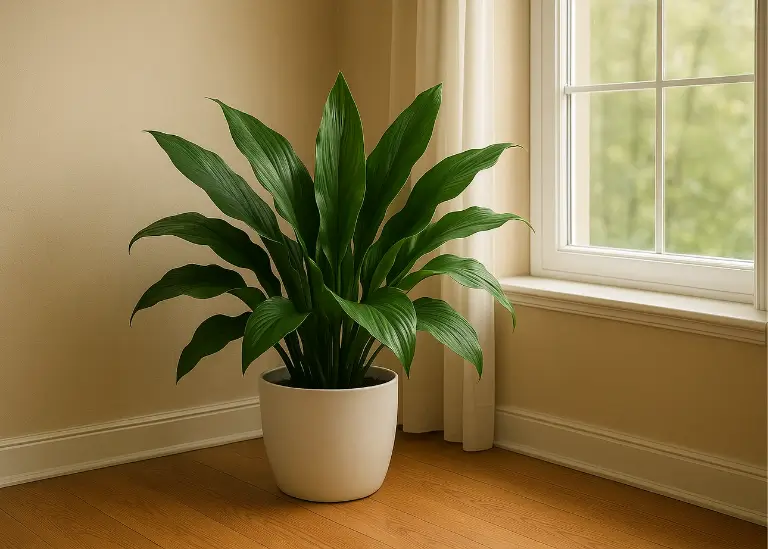
Low light specialist | 45-85°F | Nearly indestructible
True to its name, the Cast Iron Plant withstands conditions that would kill most houseplants. Its deep green, lance-shaped leaves emerge directly from the soil, creating a classic, elegant appearance that’s been beloved since Victorian times.
Why it’s Perfect: This plant earned its reputation by surviving gas-lit Victorian homes and continues to thrive in modern low-light conditions. It tolerates temperature fluctuations, irregular watering, and even poor air quality while maintaining its stately appearance.
Essential Care Requirements:
- Light: Thrives in low light; actually prefers shade over bright conditions
- Water: When soil surface feels dry; very drought tolerant
- Temperature: Extremely adaptable (45-85°F range)
- Humidity: No special requirements
Growth and Maintenance: A slow but steady grower, the Cast Iron Plant eventually reaches 2-3 feet tall. Its patience-testing growth rate is actually a benefit – it stays the perfect size for years without outgrowing its space.
Care Schedule:
- Spring-Fall: Monthly feeding with general-purpose fertilizer
- Winter: Reduce watering; no fertilizing needed
- Year-round: Remove damaged leaves at soil level
Additional Benefits: This plant is completely non-toxic to pets and children, making it safe for any household. Its tolerance for neglect makes it perfect for frequent travelers or busy beginners.
Success Tips:
- Perfect for dark bathrooms or interior hallways
- Brown leaf tips indicate fluoride sensitivity – use filtered water
- Divide clumps when repotting to create new plants
- Extremely slow growth is completely normal
5. Peace Lily (Spathiphyllum spp.)
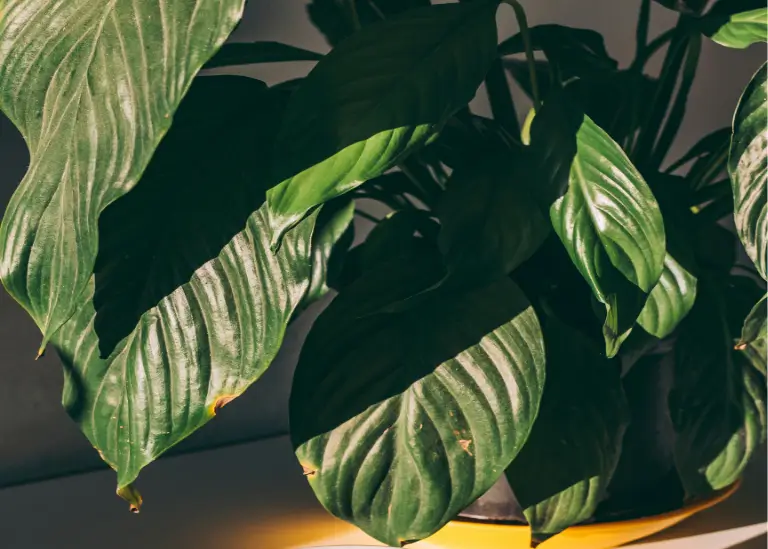
Medium indirect light | 65-80°F | Moderate care
Peace Lilies combine stunning white blooms with exceptional communication skills – they dramatically droop when thirsty, then perk up within hours of watering. Their elegant white spathes surrounding central flower spikes create year-round visual interest.
Why it’s Great: This plant literally tells you when it needs water through obvious visual cues, eliminating guesswork. Its forgiving nature and ability to bloom in indoor conditions make it rewarding for new plant parents seeking both foliage and flowers.
Essential Care Requirements:
- Light: Medium, indirect light for best flowering; tolerates lower light
- Water: Keep soil consistently moist but not waterlogged
- Temperature: Prefers warm conditions (65-80°F)
- Humidity: Appreciates moderate humidity but adapts to normal levels
Growth and Maintenance: Depending on variety, Peace Lilies range from compact 1-foot specimens to impressive 6-foot floor plants. Regular blooming cycles provide ongoing visual rewards for proper care.
Care Schedule:
- Spring-Summer: Feed with a bloom-boosting fertilizer about every month and a half to keep those white flowers coming.
- Fall-Winter: Reduce fertilizing frequency; maintain consistent moisture
- Year-round: Remove spent blooms to encourage new flowers
Additional Benefits: NASA studies confirm Peace Lilies as powerful air purifiers, removing formaldehyde, benzene, and trichloroethylene while adding humidity to dry indoor air.
Success Tips:
- Drooping leaves indicate thirst – water immediately
- Brown leaf tips suggest over-fertilizing or tap water sensitivity
- Lack of blooms usually means insufficient light
- Divide crowded plants during repotting for propagation
6. Spider Plant (Chlorophytum comosum)
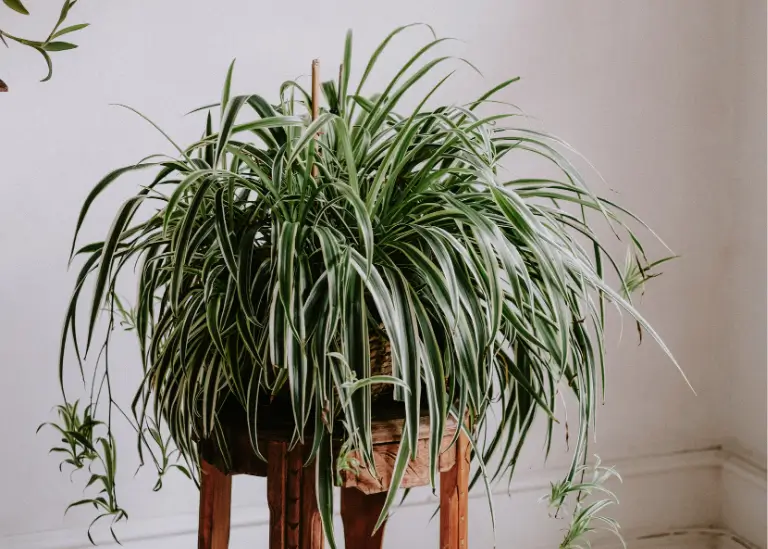
Medium to bright indirect light | 60-75°F | Easy to care
Spider Plants charm beginners with their graceful, arching grass-like foliage and incredible generosity in producing “babies” or plantlets on long runners. These non-toxic plants make perfect hanging basket specimens while actively purifying indoor air.
Why it’s Ideal: This adaptable plant forgives watering mistakes and rewards proper care by producing numerous plantlets for easy propagation. Because it’s non-toxic, this plant is a safe pick for households with kids or pets who like to nibble.
Essential Care Requirements:
- Light: Place in bright, indirect light for the prettiest striping on the leaves and the most baby plant offshoots
- Water: When top inch of soil feels dry; prefers slight drying between waterings
- Temperature: Cool to moderate temperatures (60-75°F)
- Humidity: Normal household humidity is sufficient
Growth and Maintenance: Spider Plants form attractive clumps 6-12 inches tall with cascading runners extending 2-3 feet, making them perfect for elevated displays where plantlets can dangle freely.
Care Schedule:
- Spring-Summer: Monthly balanced liquid fertilizer applications
- Fall-Winter: Reduce feeding frequency; maintain regular watering schedule
- Year-round: Propagate plantlets when roots develop
Additional Benefits: Excellent air purifier that removes formaldehyde and xylene while adding oxygen. The continuous production of plantlets provides endless opportunities for sharing plants with friends.
Success Tips:
- Variegated varieties need brighter light to maintain coloring
- Brown leaf tips indicate fluoride sensitivity or low humidity
- Plantlets can be rooted in water or soil while still attached
- Remove runners if you prefer a more compact plant
7. Philodendron (Philodendron hederaceum)
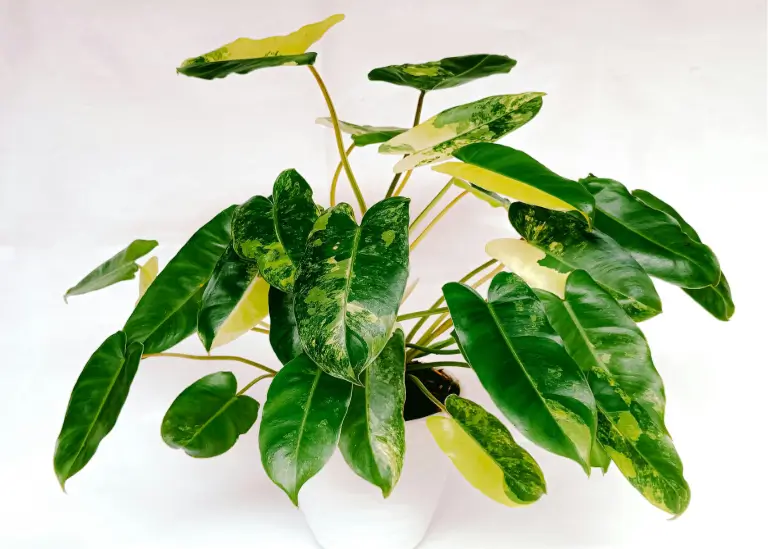
Low to bright indirect light | 65-80°F | Very easy care
Heartleaf Philodendrons offer fast-growing satisfaction with their glossy, heart-shaped leaves and trailing vines. Similar to Pothos in care requirements, they’re incredibly forgiving while providing rapid visual rewards for new plant parents.
Why it’s Perfect: These fast-growers provide quick satisfaction and confidence-building success. Their tolerance for various light conditions and forgiving watering requirements make them ideal for learning basic plant care principles.
Essential Care Requirements:
- Light: Adapts to low light but thrives in bright, indirect light
- Water: When top inch of soil feels dry; very tolerant of occasional missed waterings
- Temperature: Prefers warm conditions (65-80°F)
- Humidity: Appreciates moderate humidity but adapts to normal levels
Growth and Maintenance: Vines easily reach 5-10 feet long indoors, perfect for hanging baskets, trailing from shelves, or climbing moss poles. Regular pruning maintains desired size and shape.
Care Schedule:
- Spring-Fall: Water-soluble fertilizer every 4-6 weeks
- Winter: Reduce feeding; maintain regular watering schedule
- Year-round: Prune for shape; propagate cuttings in water
Additional Benefits: Extremely easy water propagation makes sharing with friends simple. Fast growth provides regular visual feedback on plant health and care success.
Success Tips:
- Golden varieties tolerate lower light better than green forms
- Prune regularly to encourage bushier growth
- Root cuttings in water for foolproof propagation
- Yellowing leaves usually indicate overwatering
Read more: How to care for Golden Crocodile Philodendron
8. Monstera (Monstera deliciosa)
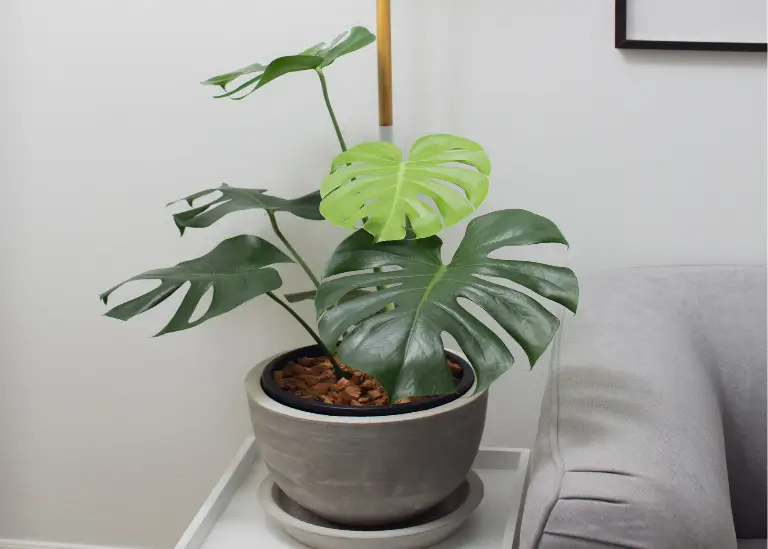
Bright indirect light | 65-85°F | Moderate care
The iconic Swiss Cheese Plant creates dramatic focal points with its large, glossy leaves developing characteristic splits and holes as they mature. It may look like a fancy tropical, but it’s actually quite easygoing—perfect if you want a bold, eye-catching plant without the drama.
Why it’s Great: This trendy plant offers dramatic visual impact while being more forgiving than its exotic appearance suggests. The development of leaf fenestrations provides ongoing excitement and photo opportunities for social media enthusiasts.
Essential Care Requirements:
- Light: Bright, indirect light for best fenestration development
- Water: Give it a drink every week or two, but only after the soil has had a chance to dry out
- Temperature: Warm conditions preferred (65-85°F)
- Humidity: Benefits from moderate to high humidity
Growth and Maintenance: Can reach impressive 6-8 feet tall and wide indoors with proper support. Providing a moss pole encourages larger leaf development and better fenestration patterns.
Care Schedule:
- Growing Season: Balanced fertilizer every 4-6 weeks during active growth
- Winter: Reduce fertilizing frequency; maintain consistent watering
- Year-round: Wipe leaves weekly to remove dust; provide support structure
Additional Benefits: Creates stunning architectural presence in any room while being relatively low-maintenance once established. The evolving leaf patterns provide ongoing visual interest.
Success Tips:
- Fenestrations develop with maturity and proper light – be patient
- Provide climbing support for largest leaf development
- Aerial roots are normal – don’t remove them
- Dust leaves regularly for optimal photosynthesis
Read more: How to Care for a Monstera (Beginner Indoor Guide)
9. Chinese Evergreen (Aglaonema spp.)
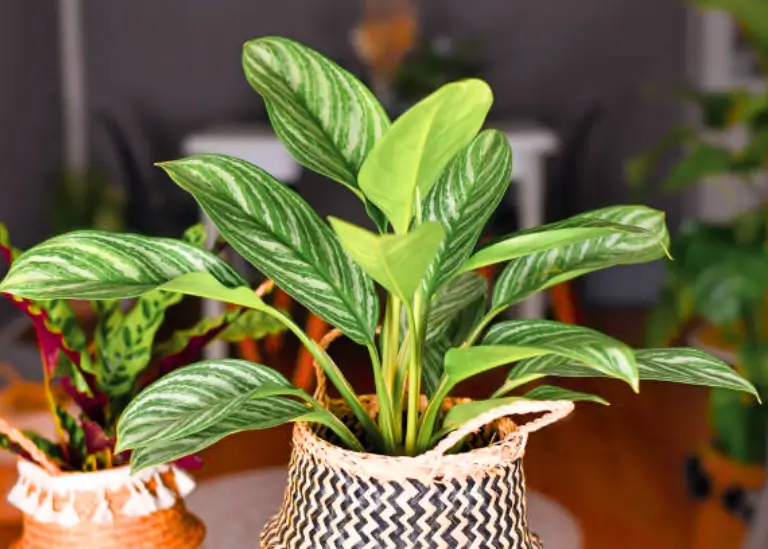
Low to medium light | 65-80°F | Easy to grow
Chinese Evergreens bring vibrant color to low-light spaces with their beautifully patterned oval leaves in stunning combinations of green, silver, pink, and red. These slow-growing beauties add tropical flair without demanding bright light.
Why it’s Ideal: These plants thrive in office lighting conditions while providing colorful foliage that rivals flowering plants. Their slow growth means they maintain perfect proportions for years without frequent repotting.
Essential Care Requirements:
- Light: Low to medium, indirect light; avoid direct sunlight which can scorch leaves
- Water: Stick your finger in the soil—if the top two inches are dry, go ahead and water
- Temperature: Prefers warm conditions (65-80°F); avoid cold drafts
- Humidity: Normal household humidity is adequate
Growth and Maintenance: Typically grows in attractive clumps 1-3 feet tall and wide, making them perfect for tabletops, desks, or floor displays in darker areas of the home.
Care Schedule:
- Spring-Fall: Monthly diluted liquid fertilizer applications
- Winter: Reduce feeding frequency; maintain regular watering
- Year-round: Remove yellowing leaves at base of plant
Additional Benefits: Provides colorful foliage in challenging low-light locations where flowering plants won’t survive. The variety of available patterns and colors offers options for any decor style.
Success Tips:
- Colorful varieties need slightly more light than plain green forms
- Cold drafts cause leaf damage – keep away from air conditioning vents
- Slow growth is completely normal for this species
- All parts are toxic to pets if ingested
Safety note: Keep away from children and pets as leaves contain compounds that are toxic if ingested.
10. Rubber Plant (Ficus elastica)
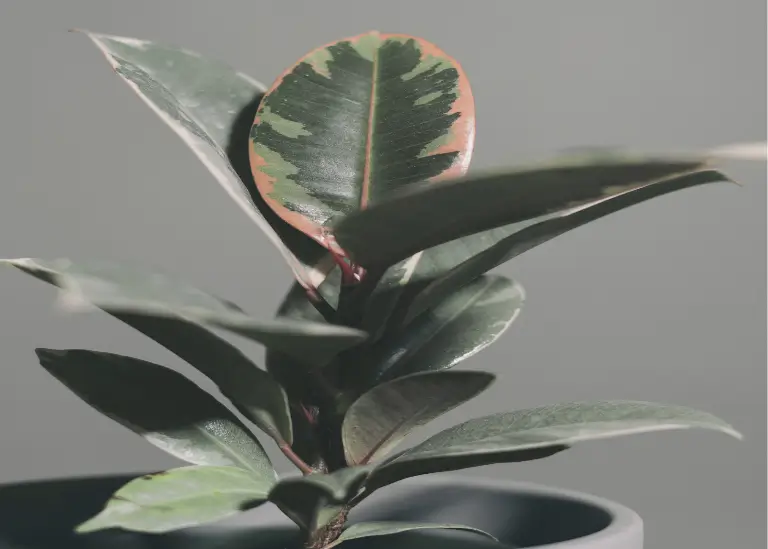
Medium to bright indirect light | 65-80°F | Moderate care
Rubber Plants make bold architectural statements with their large, glossy, oval-shaped leaves and upright growth habit. These sturdy trees adapt to various light conditions while creating dramatic vertical presence in any room.
Why it’s Great: Despite their impressive size potential, Rubber Plants are remarkably adaptable and forgiving. Their substantial presence provides immediate visual impact while being easier to care for than many smaller houseplants.
Essential Care Requirements:
- Light: Thrives in medium to bright, indirect light where it can grow steadily without scorching
- Water: When soil feels slightly dry to the touch
- Temperature: Prefers warm conditions (65-80°F)
- Humidity: Normal household humidity is sufficient
Growth and Maintenance: Can reach up to 10 feet tall indoors but responds well to pruning for size control. The upright growth habit makes them perfect for filling vertical spaces and empty corners.
Care Schedule:
- Spring-Fall: Bi-weekly fertilizing during active growing season
- Winter: Monthly fertilizing; reduce watering frequency
- Year-round: Wipe leaves weekly to maintain shine and photosynthesis efficiency
Additional Benefits: The substantial size and glossy leaves create impressive focal points while the sturdy nature makes them suitable for high-traffic areas where smaller plants might be damaged.
Success Tips:
- Burgundy varieties tolerate lower light than traditional green forms
- Regular leaf cleaning prevents pest issues and maintains appearance
- Pruning encourages bushier growth and controls height
- The plant’s milky sap can irritate sensitive skin, so wear gloves if you tend to react
11. Jade Plant (Crassula ovata)
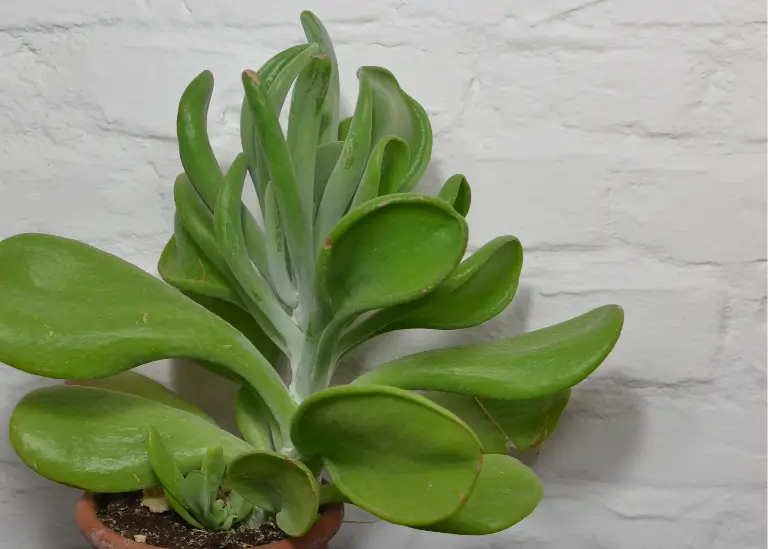
Bright light to full sun | 65-75°F | Low maintenance – Easy to propagate
Jade Plants offer decades of companionship with their thick, glossy, coin-shaped leaves and woody stems that develop into miniature tree forms over time. These succulents grow slowly, but the payoff is worth it—they can live for decades and sometimes reward you with a rare bloom.
Why it’s Perfect: This succulent teaches proper watering habits through its “soak and dry” requirements while being nearly impossible to kill with neglect. Many Jade Plants become family heirlooms, passed down through generations.
Essential Care Requirements:
- Light: Bright light to full sun for compact growth and potential flowering
- Water: Deep watering followed by complete soil drying; typically every 2-3 weeks
- Temperature: Prefers moderate temperatures (65-75°F)
- Humidity: Low humidity preferred; excellent drainage essential
Growth and Maintenance: Slow growth eventually produces impressive specimens 2-5 feet tall with thick, tree-like trunks. The compact growth habit makes them perfect for sunny windowsills and desks.
Care Schedule:
- Spring-Summer: Half-strength fertilizer once per season
- Fall-Winter: No fertilizing; reduce watering frequency significantly
- Year-round: Ensure excellent drainage; rotate for even growth
Additional Benefits: Long-lived specimens become conversation pieces and can eventually produce small, star-shaped white or pink flowers under proper conditions.
Success Tips:
- Wrinkled leaves indicate underwatering; soft, translucent leaves mean overwatering
- Use cactus soil mix for proper drainage
- Propagate easily from leaf or stem cuttings
- Cool winter temperatures encourage potential flowering
Safety note: Toxic to pets if ingested.
12. Aloe Vera (Aloe barbadensis miller)
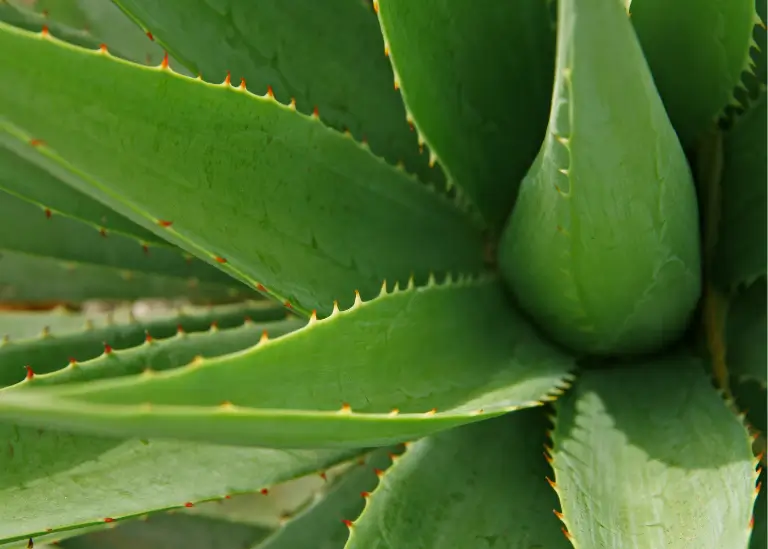
Bright light to full sun | 60-80°F | Very low maintenance – Easy to grow
Aloe Vera combines practical benefits with attractive appearance, offering soothing gel for minor burns while displaying distinctive thick, serrated, spear-shaped leaves. This useful succulent thrives with minimal care in sunny locations.
Why it’s Ideal: Beyond its medicinal properties, Aloe Vera demonstrates classic succulent care principles while providing practical benefits. The thick leaves store water, making drought tolerance its specialty.
Essential Care Requirements:
- Light: Bright, direct sunlight for best growth and gel production
- Water: Deep but infrequent watering; allow complete soil drying between applications
- Temperature: Comfortable in normal home temperatures (60-80°F)
- Humidity: Prefers dry conditions with excellent air circulation
Growth and Maintenance: Typically grows 1-2 feet tall while producing offsets (pups) around the base for easy propagation. Prefers slightly tight pots for best root health.
Care Schedule:
- Spring: Light feeding if desired, though generally unnecessary
- Summer: Regular deep watering when soil is completely dry
- Fall-Winter: Minimal watering; no fertilizing required
Additional Benefits: The clear gel inside mature leaves soothes minor burns, cuts, and skin irritations, making it a practical addition to any kitchen or bathroom windowsill.
Success Tips:
- Only harvest gel from mature, thick leaves
- Brown leaf tips indicate overwatering or poor drainage
- Pups can be separated and potted individually
- Flowering stalks appear on mature plants in bright conditions
13. Haworthia (Haworthia spp.)
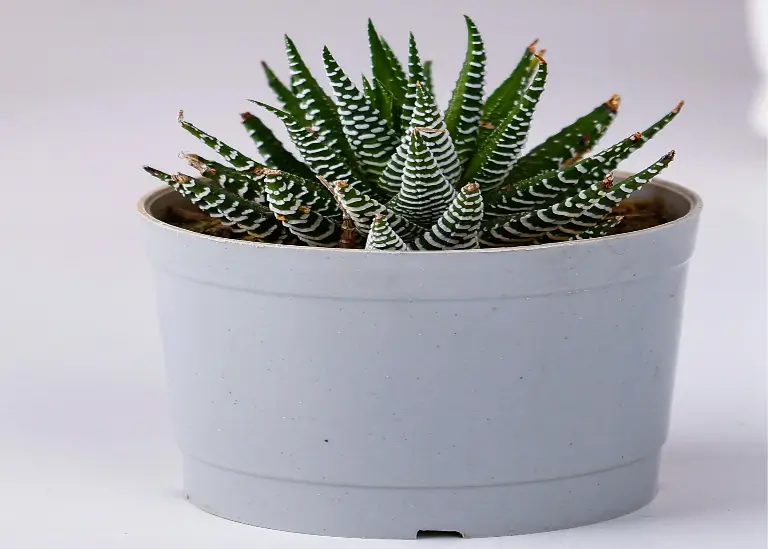
Bright indirect light | 65-80°F | Hard to kill
Often called “Zebra Plants” for their distinctive white markings, Haworthias offer succulent beauty in compact sizes perfect for desks and windowsills. These slow-growing gems stay small while providing architectural interest with minimal care requirements.
Why it’s Perfect: These compact succulents are nearly impossible to overwater when following proper care schedules. Their small size makes them perfect for beginners with limited space or those wanting to start a succulent collection.
Essential Care Requirements:
- Light: Bright, indirect light; avoid harsh direct sunlight which can cause burning
- Water: About every 2–3 weeks, but only once the soil is completely bone dry
- Temperature: Prefers moderate temperatures (65-80°F)
- Humidity: Low humidity with good air circulation
Growth and Maintenance: Remains compact at 3-5 inches tall while slowly forming attractive clusters through offset production. Perfect for small containers and grouped displays.
Care Schedule:
- Spring: Single feeding with succulent fertilizer if desired
- Summer-Fall: Regular watering when soil is completely dry
- Winter: Minimal watering; no fertilizing required
Additional Benefits: Completely non-toxic to pets and children, making them safe for any household. Their compact size allows for easy collection building and arrangement flexibility.
Success Tips:
- Reddish coloring indicates too much direct sunlight
- Soft, translucent leaves mean overwatering
- Offset division provides easy propagation
- Multiple varieties can be grouped for visual interest
14. Kalanchoe (Kalanchoe blossfeldiana)

Bright light | 65-75°F | Easy to grow
Kalanchoe brings continuous color to sunny locations with dense clusters of small, vibrant flowers in red, pink, yellow, or white that persist for weeks. This flowering succulent combines easy care with reliable blooming performance.
Why it’s Great: This succulent offers the reward of regular blooms while maintaining typical succulent care simplicity. The long-lasting flowers provide weeks of color, making it more rewarding than many flowering houseplants.
Essential Care Requirements:
- Light: Bright light for best flowering; some direct sun is beneficial
- Water: When soil surface feels dry; avoid waterlogging
- Temperature: Prefers moderate temperatures (65-75°F)
- Humidity: Normal to low humidity with good air circulation
Growth and Maintenance: Usually remains compact under 12 inches tall while producing successive flushes of flowers throughout the growing season. Deadheading spent blooms encourages continued flowering.
Care Schedule:
- Blooming Period: Monthly balanced fertilizer to support flower production
- Post-Bloom: Reduce fertilizing; maintain regular watering
- Year-round: Deadhead spent flowers promptly
Additional Benefits: Provides reliable color in sunny locations where many flowering plants struggle. The succulent nature means it tolerates occasional watering lapses better than traditional flowering plants.
Success Tips:
- Pinch flowers as they fade to encourage new blooms
- Bright light is essential for flower production
- Reduce watering after blooming period for rest
- Can be placed outdoors in summer for enhanced flowering
Safety note: Toxic to cats and dogs if ingested.
RELATED READING:
- 7 Tips for Treating Root Rot in Houseplants
- 15+ Common Houseplant Mistakes to Avoid
- How to Clean Houseplants: A Step-by-Step Guide
FAQs about The Best Indoor Plants for Beginners
-
What is the best indoor plant to start with?
The Pothos or Snake Plant are the best plants to start with. They are widely available, inexpensive, and incredibly forgiving of beginner mistakes like under- or over-watering.
-
Which plant purifies the air the most?
While many plants purify air, Peace Lilies, Snake Plants, and Spider Plants are among the most effective, according to NASA’s Clean Air Study, removing toxins like formaldehyde, benzene, and trichloroethylene.
-
What is the easiest thing to grow indoors?
The easiest things to grow indoors are succulents like Jade and Haworthia, and foliage vines like Pothos and Philodendron. They require minimal care and propagate easily.
-
What’s the healthiest houseplant?
The best ones are those that clean the air a bit and lift your spirits just by being there. Snake Plants and Peace Lilies are excellent for air purification, while plants like Spider Plants and Aloe Vera are non-toxic and safe for homes with pets and children.
-
How to start indoor plants for beginners?
Start by choosing one easy plant from this list that matches your light conditions. Always use a pot with a drainage hole and a well-draining potting mix to keep roots happy and healthy. Water only when needed by checking the soil, and place your new plant in its ideal location. Most importantly, enjoy the process!
